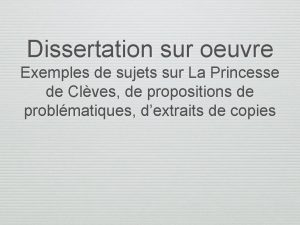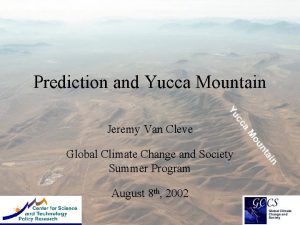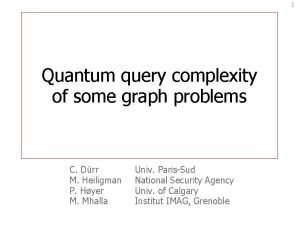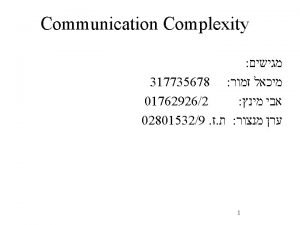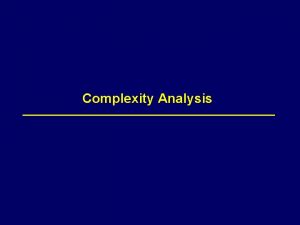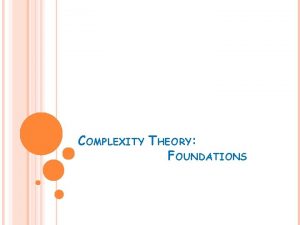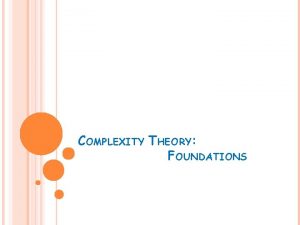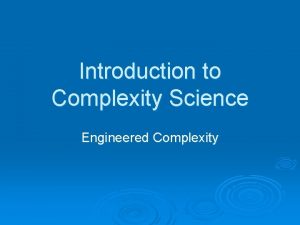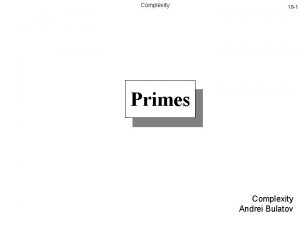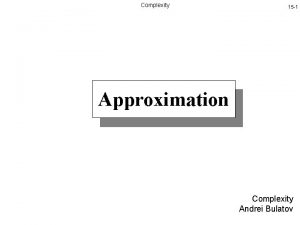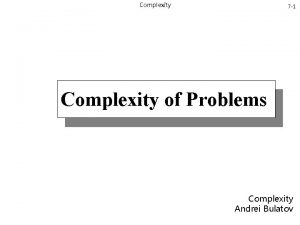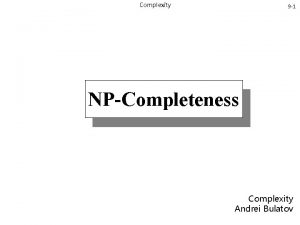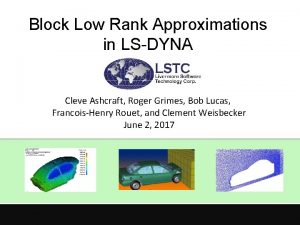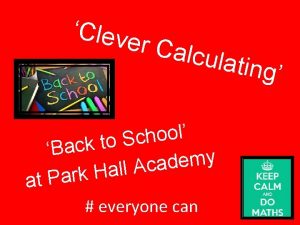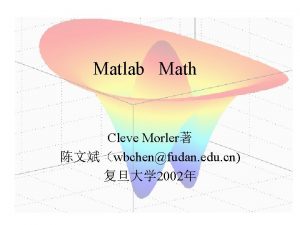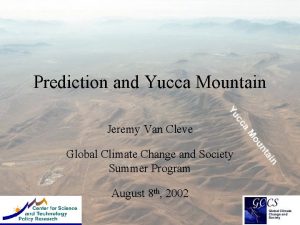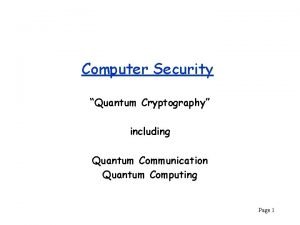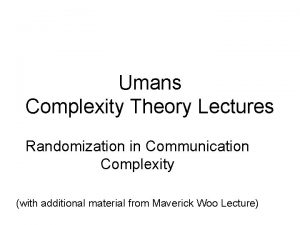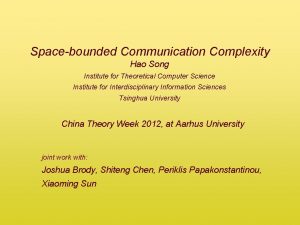Quantum Communication Complexity Richard Cleve Institute for Quantum














































- Slides: 46

Quantum Communication Complexity Richard Cleve Institute for Quantum Computing University of Waterloo Aug 2, 2005 1

1. Preliminaries 2

How does quantum information affect the communication costs of information processing tasks? • Potential applications • Context in which to explore interesting properties of quantum information • Interplay with quantum algorithms, nonlocality, and information theory 3

How much classical information in n qubits? 2 n 1 complex numbers are needed to describe an arbitrary n-qubit pure quantum state: 000 + 001 + 010 + + 111 Does this mean that an exponential amount of classical information is somehow stored in n qubits? No … Holevo’s Theorem [1973] implies: cannot extract more than n bits from n qubits 4

Holevo’s Theorem Easy case: ψ n qubits U b 1 b 2. . . bn cannot convey more than n bits! Hard case (the general case): b 1 b 2 b 3 bn ψ n qubits m qubits 0 0 0 U b 1 b 2 b 3 bn bn+1 bn+2 bn+3 bn+4 bn+m (proof omitted here) 5

Entanglement & signaling Example of an entangled state: qubit Can be used to perform some intriguing feats, such as teleportation, superdense coding, and “pseudo-telepathy” Can entangled states be used to “signal instantaneously”? No … any operation performed on one qubit has no affect on the state of the other qubit 6

Basic communication scenario Goal: convey n bits from Alice to Bob x 1 x 2 xn Alice Resources Bob x 1 x 2 xn 7

Basic communication scenario Bit communication: Cost: n Bit communication & prior entanglement: Cost: n [H ’ 73] [BW ’ 92] Qubit communication: Cost: n Qubit communication & prior entanglement: Cost: n/2 superdense coding 8

2. Communication complexity 9

Classical communication complexity x 1 x 2 xn y 1 y 2 yn f (x, y) E. g. equality function: f (x, y) = 1 if x = y, and 0 if x y Any deterministic protocol requires n bits communication Probabilistic protocols can solve with only O(log(n/ )) bits communication (error probability ) [Yao ’ 79] 10

Classical communication complexity x 1 x 2 xn y 1 y 2 yn x = y? Probabilistic protocol for Equality ( = 1/n): px(T) = x 0 + x 1 T + x 2 T 2 + … + xn 1 T n 1 py(T) = y 0 + y 1 T + y 2 T 2 + … + yn 1 T n 1 Arithmetic modulo m, for a prime m between n 2 and 2 n 2 Alice: pick random t {0, 1, …, m 1} send (t, px(t ) mod m) to Bob (this is only 4 log (n) bits) Bob: accept iff px(t) = py(t) mod m (err prob < n/n 2 = 1/n) 11

Quantum communication complexity x 1 x 2 xn y 1 y 2 yn Qubit communication qubits Prior entanglement entangled qubits x 1 x 2 xn y 1 y 2 yn bits [Y ’ 93] [CB ’ 97] f (x, y) 12

Appointment scheduling 1 2 3 4 5 . . . n x= 01101… 0 1 2 3 4 5 . . . n y= 10011… 1 i (xi = yi = 1) Classically, (n) bits necessary to succeed with prob. 3/4 For all > 0, O(n 1/2 log n) qubits sufficient for error prob. < [KS ’ 87] [BCW ’ 98] 13

Search problem 1 Given: 2 3 4 5 6 . . . n x= 000010… 1 log n i 1 b b x accessible via queries i b b xxii Ux Alternate notation Goal: find i {1, 2, …, n} such that xi = 1 Classically: (n) queries are necessary Quantum mechanically: O(n 1/2) queries are sufficient [G ’ 96] 14

1 2 3 4 5 6 . . . n Alice x= 011010… 0 Bob y= 100110… 1 x y = 0 0 1 0 … 0 i x y 0 0 b i y x x y 0 0 b Bob Alice Bob Communication per x y-query: 2(log n + 3) = O(log n) 15

Appointment scheduling: epilogue Bit communication: Cost: θ( n) Bit communication & prior entanglement: Cost: θ( n 1/2) [R ’ 02] [AA ’ 03] Qubit communication: nn 1/21/2)log(n)) Cost: θ( O( Qubit communication & prior entanglement: Cost: θ( n 1/2) 16

Restricted version of equality Precondition (i. e. promise): either x = y or (x, y) = n/2 Hamming distance Classically, (n) bits communication are still necessary for an exact solution Quantum mechanically, O(log n) qubits communication are sufficient for an exact solution (It’s a distributed variant of the Deutsch-Jozsa problem … a “constant” vs. “balanced” distinguishing problem) [BCW ’ 98] 17

Classical lower bound (*skipped) Theorem: If S {0, 1}n has the property that, for all x, x′ S, their intersection size is not n/4 then S < 1. 99 n Let some protocol solve restricted equality with k bits comm. ● 2 k conversations of length k ● approximately 2 n/ n input pairs (x, x), where Δ(x) = n/2 Therefore, 2 n/2 k n input pairs (x, x) that yield same conv. C Define S = {x : Δ(x) = n/2 and (x, x) yields conv. C } For any x, x′ S, input pair (x, x′ ) also yields conversation C Therefore, Δ(x, x′) n/2, implying intersection size is not n/4 Theorem implies 2 n/2 k n < 1. 99 n , so k > 0. 007 n [Frankl and Rödl, 1987] 18

Quantum protocol For each x {0, 1}n, define Protocol: 1. Alice sends x to Bob (log(n) qubits) 2. Bob measures state in a basis that includes y Correctness of protocol: If x = y then Bob’s result is definitely y If (x, y) = n/2 then x y = 0, so result is definitely not y Question: How much communication if error prob. ¼ is ok? Answer: just 2 bits are sufficient! 19

Exponential quantum vs. classical separation in bounded-error models : a log(n)-qubit state U: unitary operation (described classically) on log(n) qubits M: two-outcome measurement Output: result of applying M to U O(log n) quantum vs. (n 1/4 / log n) classical communication [R ’ 99] 20

3. Quantum speed-up is not always possible 21

Inner product IP(x, y) = x 1 y 1 + x 2 y 2 + + xn yn mod 2 Classically, (n) bits of communication are required, even for bounded-error protocols Quantum protocols also require (n) communication [KY ’ 95] [CNDT ’ 98] [NS ’ 02] 22

Recall Deutsch’s problem Let f : {0, 1} be of the form f(x) = a 1 x + a 0 mod 2 Given: black box for f Goal: determine a 1 (a 1 = 0 implies “constant”; a 1 = 1 implies “balanced”) Classically, 2 queries are necessary Quantum mechanically, 1 query is sufficient 23

Bernstein-Vazirani problem (multidimensional Deutsch problem) Let f(x 1, x 2, …, xn) = a 1 x 1 + a 2 x 2 + + an xn + a 0 mod 2 Given: 0 x 1 H 0 x 2 H H 0 xn. H 1 b H f H x 1 a 1 H x 2 a 2 H H xn an H b 1 f( x 1, x 2, …, xn) Goal: determine a 1, a 2 , …, an Classically, n +1 queries are necessary Quantum mechanically, 1 query is sufficient 24

Lower bound for inner product IP(x, y) = x 1 y 1 + x 2 y 2 + + xn yn mod 2 Proof: x 1 x 2 xn y 1 y 2 yn z Alice and Bob’s IP protocol inverted x 1 x 2 xn y 1 y 2 yn z IP(x, y) 25

Lower bound for inner product IP(x, y) = x 1 y 1 + x 2 y 2 + + xn yn mod 2 Proof: x 1 x 2 xn 0 0 0 1 H H H x 1 x 2 xn H 1 H Alice and Bob’s IP protocol inverted x 1 x 2 xn [BV, 1993] Since n bits are conveyed from Alice to Bob, n qubits communication necessary (by Holevo’s Theorem) 26

4. Simultaneous messages to a third party 27

Equality revisited in simultaneous message model x 1 x 2 xn y 1 y 2 yn f (x, y) Equality function: f (x, y) = 1 if x = y 0 if x y Exact protocols: require 2 n bits communication 28

Equality revisited in simultaneous message model x 1 x 2 xn 1 0 1 1 y 1 y 2 yn 1 0 1 1 f (x, y) Bounded-error protocols with a shared random key: require only O(1) bits communication Error-correcting code: C(x) = 0 1 1 1 0 0 1 1 0 C(y) = 0 1 1 0 0 0 1 0 random k 29

Equality revisited in simultaneous message model x 1 x 2 xn Bounded-error protocols without a shared key: y 1 y 2 yn f (x, y) Classical: θ(n 1/2) Quantum: θ(log n) [A ’ 96] [NS ’ 96] [BCWW ’ 01] 30

Quantum fingerprints Question 1: how many orthogonal states in k qubits? Answer: 2 k Question 2: how many almost orthogonal* states in k qubits? (* where | x y | ≤ ) k Answer: 2 c 2 , for some constant c > 0 Question 3: does this enable k qubits to store c 2 k bits? (In other words, log n + O(1) qubits to store n bits? ) Answer: no … recall Holevo’s Theorem However, it does enable one to check if x = y or x ≠ y by only examining x and y 31

Quantum fingerprints Let 000 , 001 , …, 111 be 2 n states on log n + O(1) qubits such that | x y | ≤ for all x ≠ y Given x y , one can check if x = y or x ≠ y as follows: 0 x y H H if x = y, Pr[output = 0] = 1 ≠ y, Pr[output = 0] = (1+ 2)/2 S W A P Intuition: 0 x y + 1 y x 32

Quantum protocol for equality in simultaneous message model x 1 x 2 xn y 1 y 2 yn x y Orthogonality test 33

5. One-way communication 34

Hidden matching problem Inputs: x {0, 1}n M= matching on {1, 2, …, n} (partition into pairs) Output: (i, j, xi xj), such that (i , j ) M Only one-way communication (Alice to Bob) is permitted Quantum protocol can be exponentially more efficient than any classical protocol—even with a shared key [BJK ’ 04] 35

Hidden matching problem Inputs: x {0, 1}n M= matching on {1, 2, …, n} Output: (i, j, xi xj), (i, j) M Classically, one-way communication is ( n) for bounded-error even with a shared classical key (the proof is omitted here) Intuition: With Alice’s message Bob can repeat his side of the protocol using several edge-disjoint matchings, which yields information about several xi xj bits … 36

Hidden matching problem Inputs: x {0, 1}n M= matching on {1, 2, …, n} Output: (i, j, xi xj), (i, j ) M Quantum protocol that uses only log n qubits: Alice sends (log n qubits) to Bob measures in the basis { i j | (i, j ) M }, and then uses the outcome’s relative phase to deduce xi xj 37

6. Nonlocality revisited 38

Communication complexity with distributed outputs (1 bit) y (1 bit) a (1 bit) where a, b, x, y satisfy some relation b (1 bit) inputs: x outputs: E. g. “Bell’s Theorem” Goal: a b = x y with zero communication With classical resources, Pr[a b = x y] ≤ 0. 75 With 00 + 11 prior entanglement, Pr[a b = x y] = 0. 853… [B ’ 64] [CHSH ’ 69] 39

Distributed outputs: “spooky Deutsch- Jozsa” inputs: x (n bits) y (n bits) outputs: a (log n bits) b (log n bits) Precondition: either x = y or (x, y) = n/2 Required postcondition: a = b iff x = y With classical resources, (n) bits of communication needed for an exact solution With ( 00 + 11 )log n prior entanglement, no communication is needed at all [BCT ’ 99] 40

Distributed-output restricted equality Bit communication: Cost: θ( n) Bit communication & prior entanglement: Cost: zero Qubit communication: Cost: log n Qubit communication & prior entanglement: Cost: zero 41

Distributed-output hidden matching Inputs: x {0, 1}n M= matching on {1, 2, …, n} (partition into pairs) Outputs: a {0, 1}log n (b, i, j), such that 1. (i, j) M 2. (a b)·(i j) = xi xj With prior entanglement, no communication necessary; without prior entanglement, one-way communication is ( n), even to achieve success probability ¾ [B ’ 04] 42

Some open problems • Develop some “Killer Apps” • Exponential separation between one-round quantum and multi-round classical? • Are the qubit communication and the prior entanglement models equivalent? • The distributed-output scenario can be viewed as a two-prover interactive proof system, raising questions about their expressive power in a quantum world (may come up on Thursday …) 43

Selected references I • Z. Bar-Yossef, T. S. Jayram, I. Kerenidis, “Exponential separation of quantum and classical one-way communication complexity”, Proceedings of 36 th Annual ACM Symposium on Theory of Computing, pages 128 -137, 2004. • G. Brassard, “Quantum communication complexity”, Foundations of Physics, 33(11): 15931616, 2003. • R. de Wolf, “Quantum communication and complexity”, Theoretical Computer Science, 287(1): 337 -353, 2002. Available at http: //homepages. cwi. nl/~rdewolf/ • G. Brassard, R. Cleve, A. Tapp, “Cost of exactly simulating quantum entanglement with classical communication”, Physical Review Letters, 83(9): 1874 -1877, 1999. • H. Buhrman, R. Cleve, W. van Dam, “Quantum entanglement and communication complexity”, SIAM Journal on Computing, 2000. • H. Buhrman, R. Cleve, A. Wigderson, “Quantum vs. classical communication and computation”, Proceedings of the 30 th Annual ACM Symposium on Theory of Computing, pages 63 -68, 1998. • R. Cleve, H. Buhrman, “Substituting quantum entanglement for communication”, Physical Review A, 56(2): 1201 -1204, 1997. 44

Selected references II • R. Cleve, W. van Dam, P. Høyer, A. Tapp, “Quantum entanglement and the communication complexity of the inner product function”, Lecture Notes in Computer Science, 1509: 61 -74, 1999. • A. Holevo, “Bounds on the quantity of information transmitted by a quantum communication channel”, Problems of Information Transmission, 9: 177 -183, 1973. • B. Kalyanasundaram, G. Schnitger, “The probabilistic communication complexity of set intersection”, Proceedings of 2 nd Annual IEEE Conference on Structure in Complexity Theory, pages 41 -47, 1987. • I. Kremer, Quantum Communication, Master’s thesis, Hebrew University, Computer Science Department, 1995. • R. Raz, “Exponential separation of quantum and classical communication complexity”, Proceedings of 31 st Annual ACM Symposium on Theory of Computing, pages 358 -367, 1999. • A. C. -C. Yao, “Some questions related to distributed computing”, Proceedings of 11 th Annual ACM Symposium on Theory of Computing, pages 209 -213, 1979. • A. C. -C. Yao, “Quantum circuit complexity”, Proceedings of 34 th Annual IEEE Symposium on Foundations of Computer Science, pages 352 -361, 1993. 45

46
 Exemple dissertation princesse de clèves
Exemple dissertation princesse de clèves He slapped her
He slapped her Jeremy van cleve
Jeremy van cleve Time space complexity of algorithm
Time space complexity of algorithm Quantum query complexity of some graph problems
Quantum query complexity of some graph problems Power in looking for richard
Power in looking for richard Quantum physics vs quantum mechanics
Quantum physics vs quantum mechanics Quantum physics vs mechanics
Quantum physics vs mechanics Quantum edge healing institute
Quantum edge healing institute Formuö
Formuö Typiska drag för en novell
Typiska drag för en novell Tack för att ni lyssnade bild
Tack för att ni lyssnade bild Vad står k.r.å.k.a.n för
Vad står k.r.å.k.a.n för Varför kallas perioden 1918-1939 för mellankrigstiden
Varför kallas perioden 1918-1939 för mellankrigstiden En lathund för arbete med kontinuitetshantering
En lathund för arbete med kontinuitetshantering Adressändring ideell förening
Adressändring ideell förening Tidbok för yrkesförare
Tidbok för yrkesförare A gastrica
A gastrica Förklara densitet för barn
Förklara densitet för barn Datorkunskap för nybörjare
Datorkunskap för nybörjare Tack för att ni lyssnade bild
Tack för att ni lyssnade bild Mall debattartikel
Mall debattartikel Delegerande ledarstil
Delegerande ledarstil Nyckelkompetenser för livslångt lärande
Nyckelkompetenser för livslångt lärande Påbyggnader för flakfordon
Påbyggnader för flakfordon Formel för lufttryck
Formel för lufttryck Publik sektor
Publik sektor Lyckans minut erik lindorm analys
Lyckans minut erik lindorm analys Presentera för publik crossboss
Presentera för publik crossboss Vad är ett minoritetsspråk
Vad är ett minoritetsspråk Kanaans land
Kanaans land Treserva lathund
Treserva lathund Mjälthilus
Mjälthilus Claes martinsson
Claes martinsson Centrum för kunskap och säkerhet
Centrum för kunskap och säkerhet Lågenergihus nyproduktion
Lågenergihus nyproduktion Mat för idrottare
Mat för idrottare Verktyg för automatisering av utbetalningar
Verktyg för automatisering av utbetalningar Rutin för avvikelsehantering
Rutin för avvikelsehantering Smärtskolan kunskap för livet
Smärtskolan kunskap för livet Ministerstyre för och nackdelar
Ministerstyre för och nackdelar Tack för att ni har lyssnat
Tack för att ni har lyssnat Vad är referatmarkeringar
Vad är referatmarkeringar Redogör för vad psykologi är
Redogör för vad psykologi är Stål för stötfångarsystem
Stål för stötfångarsystem Atmosfr
Atmosfr Borra hål för knoppar
Borra hål för knoppar
